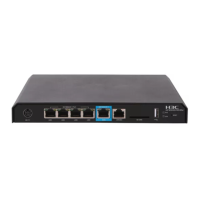17
Command and hardware compatibility
The WX1800H series, WX2500H series, WX3000H series access controllers do not support the slot
keyword or the slot-number argument.
QoS service models
This section describes several typical QoS service models.
Best-effort service model
The best-effort model is a single-service model. The best-effort model is not as reliable as other
models and does not guarantee delay-free delivery.
The best-effort service model is the default model for the Internet and ap plies to most network
applications. It uses the First In First Out (FIFO) queuing mechanism.
IntServ model
The integrated service (IntServ) model is a multiple-service model that can accommodate diverse
QoS requirements. This service model provides the most granularly differentiated QoS by identifying
and guaranteeing definite QoS for each data flow.
In the IntServ model, an application must request service from the network before it sends data.
IntServ signals the service request with the RSVP. All nodes receiving the request reserve resources
as requested and maintain state information for the application flow.
The IntServ model demands high storage and processing capabilities because it requires all nodes
along the transmission path to maintain resource state information for each flow. This model is
suitable for small-sized or edge networks. However, it is not suitable for large-sized networks, for
example, the core layer of the Internet, where billions of flows are present.
DiffServ model
The differentiated service (DiffServ) model is a multiple-service model that can meet diverse QoS
requirements. It is easy to implement and extend. DiffServ does not signal the network to reserve
resources before sending data, as IntServ does.
QoS techniques overview
The QoS techniques include the following features:
• Traffic classification.
• Traffic policing.
The following section briefly introduces these QoS techniques.
All QoS techniques in this document are based on the DiffServ model.

